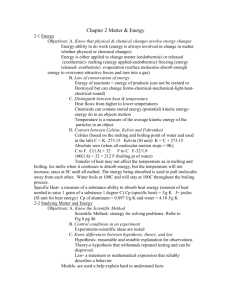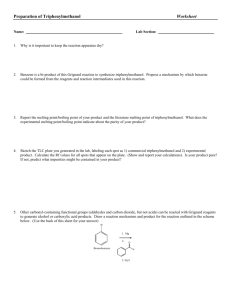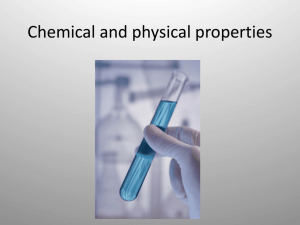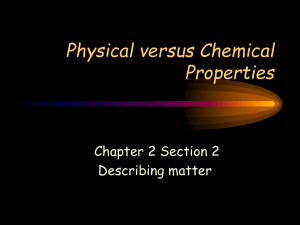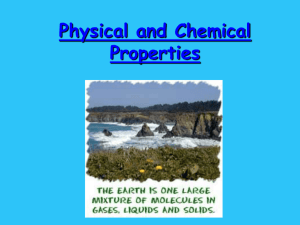Lab Packet Handout
advertisement
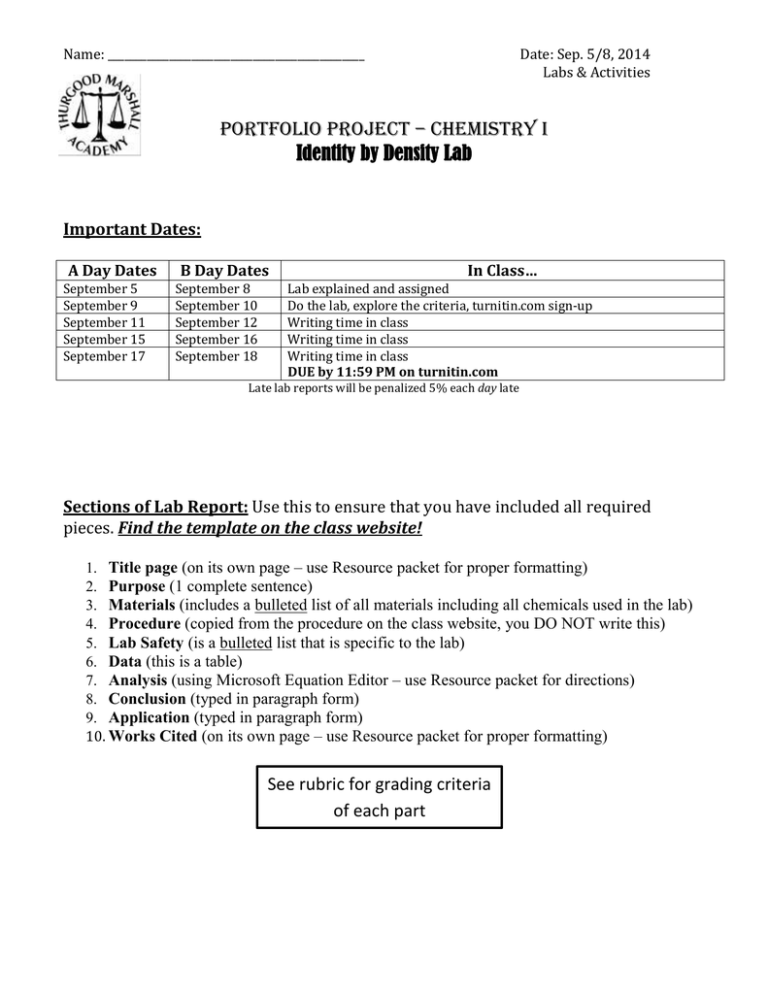
Name: ______________________________________________ Date: Sep. 5/8, 2014 Labs & Activities Portfolio Project – Chemistry I Identity by Density Lab Important Dates: A Day Dates September 5 September 9 September 11 September 15 September 17 B Day Dates September 8 September 10 September 12 September 16 September 18 In Class… Lab explained and assigned Do the lab, explore the criteria, turnitin.com sign-up Writing time in class Writing time in class Writing time in class DUE by 11:59 PM on turnitin.com Late lab reports will be penalized 5% each day late Sections of Lab Report: Use this to ensure that you have included all required pieces. Find the template on the class website! 1. Title page (on its own page – use Resource packet for proper formatting) 2. Purpose (1 complete sentence) 3. Materials (includes a bulleted list of all materials including all chemicals used in the lab) 4. Procedure (copied from the procedure on the class website, you DO NOT write this) 5. Lab Safety (is a bulleted list that is specific to the lab) 6. Data (this is a table) 7. Analysis (using Microsoft Equation Editor – use Resource packet for directions) 8. Conclusion (typed in paragraph form) 9. Application (typed in paragraph form) 10. Works Cited (on its own page – use Resource packet for proper formatting) See rubric for grading criteria of each part Introduction: Because density is an intensive property, any element should be able to be identified through a series of density measurements and calculations. The purpose of the lab is to identify the unknown element by determining its density. To do this, you will be measuring the density of your unknown element three times, from which you will calculate the average density of that element. You will then be able to compare your average density to the known density values of several different elements and calculate your percent yield to determine how accurate the experiment was. Key Terms: Intensive Property: Density = Percent Yield: Purpose: What is the purpose of this lab? Write ONE sentence only. The purpose of this lab is _____________________________________________________________________________________ __________________________________________________________________________________________________________________ __________________________________________________________________________________________________________________ Re-Phrase of Purpose: Write the purpose in a different way. Write ONE sentence only. Use this in conclusion. __________________________________________________________________________________________________________________ __________________________________________________________________________________________________________________ __________________________________________________________________________________________________________________ __________________________________________________________________________________________________________________ 2 Materials: This should be a bulleted list of your materials so that they are properly included in your lab report. They should include all chemicals as well. Don’t forget to include your unknown element NUMBER and DESCRIPTION of the element using observations. Element # _________ (description: ____________________________________________________________________________) Procedure: The procedure is provided for you but must still be included in your lab report. This procedure will be uploaded to the class website so that you can copy and paste it into your report. 1. Unequally separate the element into three mass boats. 2. Mass the three element samples on the balance. Record in data table. 3. Fill the graduated cylinder with between 20-30 mL of water. Record the exact initial volume in data table. 4. Put all of the contents of the first mass boat into the graduated cylinder with the water. Record the final volume in the data table. 5. Pour out the water and retrieve and dry the element sample. 6. Repeat steps 3-5 with the remaining two samples of the element. Lab Safety: This should be a bulleted comprehensive so that a scientist can safely repeat your experiment. 3 Data: Includes a data table. This table should be in your lab report. Measurement m a b v=a–b m/v Mass (g) Initial Volume of Water (mL) Final Volume of Water (mL) Volume of Unknown (mL) Density (g/mL) 1 2 3 Analysis: This includes all the work needed to calculate density (see bullet list). In your lab report, this should be included typed using Microsoft Equation Editor. See example on the next page. Density calculation for one of the measurements. Average calculation for the three density measurements. Average = Determine the identity of the unknown element. Your element is aluminum (Al), copper (Cu) or zinc (Zn). First, research the known densities of these elements and record them here. Element Density (g/mL) Aluminum (Al) Copper (Cu) Zinc (Zn) **Source of information: write down the MLA citation here, to use in your Works Cited page. Based on the research, what was the unknown element? Compare the average density calculated above to the known densities of the elements in the table. Use the density that is closest to the average density that was calculated. This should be written in sentence form. Percent yield calculation using the actual density average (from your data) and the expected density (from the table of known densities you researched). 4 Example of what using Equation Editor should look like: Using Microsoft Equation Editor allows you to set up your analysis like this! (Note that the numbers here are just an example and not the same as the ones expected in your report. The setup should look just like this, except for the notes in white.) For directions on how to use Equation Editor, look at your resource packet. Density of Measurement 1: 11.2g = 2.01 g mL 5.57mL Notice the UNITS! Average Density: 2.01+1.85 +1.92 5.78 = = 1.93 g mL 3 3 Based on the average density of 1.93g/mL, the element in this experiment was magnesium because it had the closest known density of 1.74g/mL.1 Percent Yield: 1.93 ´100 = 111% 1.74 A percent yield of 111% means that the density calculated in the lab was 11% above the actual density of the element. Conclusion: Includes the following criteria in complete PARAGRAPH form: Paragraph #1: Concise summary of the lab: o Rephrase of the purpose (use the second re-phrased one from pg. 2) o Define key terms from lab (pg. 2) o Briefly describe what you did in the lab (in 1 or 2 sentences) – How did you measure density? This should not be a step-by-step procedure. Paragraph #2: Summary of the results and analysis. This should include: o The three density measurements (from Data) o The average density calculated (from Analysis) o The identity of the element Sentence Starter: The identity of the unknown element is _______ because… o The percent yield of the actual density compared to the theoretical density of the element. o What does this percent yield mean? (look at 2nd white box on Equation editor sample above) Sentence Starter: A percent yield of ______% means that … 5 A Application: This will be written in complete PARAGRAPH form: This is a completely different scenario from the lab you completed. It has nothing to do with the same element. You have a new sample of an element, which is a yellow colored solid. Unfortunately, you do not have the appropriate materials to determine its density. You do, however, have the materials to measure its melting point. You follow a very similar procedure – you split your element into three smaller samples. You then carefully melt each sample using a Bunsen burner and a thermometer. The results of your melting point experiments are below: Measurement Melting Point (oC) 1 105 2 122 3 110 Calculate the average melting point of this element: Use the physical description of the element along with the average melting point calculated to research what element you have in this scenario. Use the source provided on the class website. In your paragraph include: What was the average melting point of the element? What is the identity of this element? How do you know? (use in-text citations based on your research) Both melting point and the physical description are intensive properties. Why can these be used to identify an unknown element? Why was more than the melting point needed to identify the element? Hint: if I had just given you melting point, you likely would have misidentified the element… 6 B Application: This will be written in complete PARAGRAPH form: This is a completely different scenario from the lab you completed. It has nothing to do with the same element. You have a new sample of an element, which is a silver colored solid. Unfortunately, you do not have the appropriate materials to determine its density. You do, however, have the materials to measure its melting point. You follow a very similar procedure – you split your element into three smaller samples. You then carefully melt each sample using a Bunsen burner and a thermometer. The results of your melting point experiments are below: Measurement Melting Point (oC) 1 38 2 43 3 40 Calculate the average melting point of this element: Use the physical description of the element along with the average melting point calculated to research what element you have in this scenario. Use the source provided on the class website. In your paragraph include: What was the average melting point of the element? What is the identity of this element? How do you know? (use in-text citations based on your research) Both melting point and the physical description are intensive properties. Why can these be used to identify an unknown element? Why was more than the melting point needed to identify the element? Hint: if I had just given you melting point, you likely would have misidentified the element… 76 C Application: This will be written in complete PARAGRAPH form: This is a completely different scenario from the lab you completed. It has nothing to do with the same element. You have a new sample of an element, which is a silver colored liquid. Unfortunately, you do not have the appropriate materials to determine its density. You do, however, have the materials to measure its boiling point. You follow a very similar procedure – you split your element into three smaller samples. You then carefully boil each sample using a Bunsen burner and a thermometer. The results of your boiling point experiments are below: Measurement Boiling Point (oC) 1 345 2 340 3 341 Calculate the average boiling point of this element: Use the physical description of the element along with the average boiling point calculated to research what element you have in this scenario. Use the source provided on the class website. In your paragraph include: What was the average boiling point of the element? What is the identity of this element? How do you know? (use in-text citations based on your research) Both melting point and the physical description are intensive properties. Why can these be used to identify an unknown element? Why was more than the boiling point needed to identify the element? Hint: if I had just given you boiling point, you likely would have misidentified the element… 68 D Application: This will be written in complete PARAGRAPH form: This is a completely different scenario from the lab you completed. It has nothing to do with the same element. You have a new sample of an element, which is a bluish-white colored solid. Unfortunately, you do not have the appropriate materials to determine its density. You do, however, have the materials to measure its boiling point. You follow a very similar procedure – you split your element into three smaller samples. You then carefully boil each sample using a Bunsen burner and a thermometer. The results of your boiling point experiments are below: Measurement Boiling Point (oC) 1 1744 2 1740 3 1732 Calculate the average boiling point of this element: Use the physical description of the element along with the average boiling point calculated to research what element you have in this scenario. Use the source provided on the class website. In your paragraph include: What was the average boiling point of the element? What is the identity of this element? How do you know? (use in-text citations based on your research) Both melting point and the physical description are intensive properties. Why can these be used to identify an unknown element? Why was more than the boiling point needed to identify the element? Hint: if I had just given you boiling point, you likely would have misidentified the element… 69 E Application: This will be written in complete PARAGRAPH form: This is a completely different scenario from the lab you completed. It has nothing to do with the same element. You have a new sample of an element, which is a silvery-gold colored solid. Unfortunately, you do not have the appropriate materials to determine its density. You do, however, have the materials to measure its boiling point. You follow a very similar procedure – you split your element into three smaller samples. You then carefully boil each sample using a Bunsen burner and a thermometer. The results of your boiling point experiments are below: Measurement Boiling Point (oC) 1 680 2 681 3 671 Calculate the average boiling point of this element: Use the physical description of the element along with the average boiling point calculated to research what element you have in this scenario. Use the source provided on the class website. In your paragraph include: What was the average boiling point of the element? What is the identity of this element? How do you know? (use in-text citations based on your research) Both melting point and the physical description are intensive properties. Why can these be used to identify an unknown element? Why was more than the boiling point needed to identify the element? Hint: if I had just given you boiling point, you likely would have misidentified the element… 10 6

